MacDill Air Force Base will start an investigation in January into reports that a lost African American cemetery could be inside its gates.
The cemetery once served the Port Tampa neighborhood on the northwest corner of the sprawling base. The neighborhood had a population of African American residents outside of the better known black neighborhoods in Tampa, civic leaders say.
The base has already set aside money for the inquiry, according to 6th Air Refueling Wing spokesman First Lieutenant Brandon Hanner.
“The area under question is an isolated area of the base that's got some woods on top of it,” he said. “There's no building or traffic that flows through that particular area.”
The news follows Wednesday's announcement confirming the discovery of another African American cemetery in Tampa. One hundred and forty five coffins from the former Ridgewood Cemetery were identified on part of the King High School campus.
Earlier this year, the lost Zion Cemetery was confirmed beneath a Tampa public housing complex and storefronts.
The Tampa Bay Times reported that a 1941 Works Progress Administration record puts the location of the Port Tampa cemetery near the corner of Interbay Boulevard and Manhattan Avenue.
The suspected cemetery could be in the small wooded area just to the west-northwest of the conjunction of both runways at the north end of MacDill Air Force Base in the map above.
Port Tampa City used to be separate from Tampa, incorporated in 1885 at the southern and western edge of the Interbay Peninsula. It was a working port, at the end of the railroad tracks installed by Henry B. Plant.
Port Tampa’s African American residents were largely drawn to jobs at the port, which was separate but more accessible than the larger but less accessible (before dredging) Port Tampa Bay in downtown.
The port is best known as the point of embarkation for troops leaving for the Spanish-American War. It was annexed by the city of Tampa in 1961.
Hanner stressed that the base has no information about a possible cemetery on its grounds and that the tip – which came from the Tampa Bay History Center – did not give enough information to determine with certainty whether any graves remain there.




